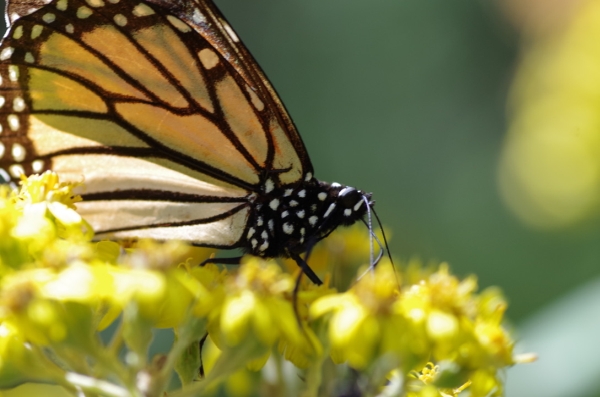Spotlight on science: A passion for conservation - Greg Mitchell
Profile of Greg Mitchell
A passion for conservation

Greg Mitchell is one of those people involved in many projects, and for whom summer is a busy time. We managed to catch up with this researcher at the Wildlife Research Division of ECCC's Science and Technology Branch at the end of an ornithology conference he co-directed to learn about his passions, his motivations, and his philosophy on work.
An ornithologist turned Monarch Butterfly specialist

A monarch butterfly in its wintering area at Piedra Herrada, Mexico, photographed by Greg.
Greg is passionate about ecology, and his thirst for learning is obvious. After finishing his undergraduate degree at the University of Guelph, he completed his master's degree at Acadia University in Nova Scotia, studying the post-nuptial ecology of boreal songbirds in the Newfoundland region.
Already an avid migratory bird enthusiast, Greg completed his PhD at the University of Guelph, studying the migration of meadow sparrows in the Bay of Fundy. He obtained his postdoctorate at the University of Western Ontario, analyzing the effect of disease on the migratory capacity of birds.
This research in ecology, physiology, and epidemiology led Greg to his current work at ECCC: understanding the threats to Canada's species at risk and migratory birds, as well as their habitats. But while he spends most of his time studying biodiversity in agricultural ecosystems, he also has another concern: the decline of the Monarch Butterfly.
Dedicated to the recovery of an endangered species

Greg and his colleagues on their way up to the monarch butterfly wintering colony at Piedra Herrada, Mexico.
Greg got hooked on Monarch Butterflies as a PhD student, when he shared his office with a student whose work focused on this species. During the winters of 2014 and 2015, the population of migratory Monarch Butterflies in the East reached an all-time low. In 2016, the governments of Mexico, the United States, and Canada decided to form the Trinational Monarch Conservation Partnership with the aim of filling large gaps in scientific data on this species. Greg's interest was well known, so he was given the mandate to co-chair this group, which he happily accepted. Today, with the support of the Canadian Wildlife Service, Ontario Region, and the Commission for Environmental Cooperation, he is working to better understand the threats facing this species at risk and implement solutions to promote its recovery.
Collaboration for conservation
The challenges of wildlife conservation are many, and Greg is committed to prioritizing cooperation to achieve their goals. “It is essential to surround yourself with people who have different areas of expertise in order to be effective. My approach is to be as respectful, friendly, and accommodating as possible with my peers, and to remain optimistic about achieving our goals as a team, whether within ECCC or with the Trinational Monarch Conservation Partnership,” he says.

Greg and his son Tyler in a milkweed field participating in the Monarch Blitz.
This collaboration has enabled Greg to be involved in a number of projects aimed at learning more about the Monarch Butterfly and its habitat. One of these projects involves estimating the number of milkweed plants available and assessing the fluctuation of the Monarch population in Canada. As milkweeds are the only plants on which Monarch Butterflies lay their eggs, the question is whether there are enough milkweeds for the Monarch Butterfly population to recover. With the project nearing completion, Greg and his team suggest that there is a shortage of milkweed, and more of it needs to be planted.
“I like to remind myself not to underestimate the importance and power of small actions. For example, if more of us planted native flowers in our gardens, we could make a huge difference for these butterflies!” says Greg. This opinion is linked to another collaborative study close to his heart: together with a colleague from the University of Ottawa, Greg is studying the nutritional value of native and non-native plants for Monarch Butterflies. “Our preliminary results suggest that some flowers are more nutritious than others in terms of energy for Monarch Butterflies migrating south in the fall. It's exciting, because we'll eventually be able to suggest to people what kinds of flowers to plant in their gardens to help Monarch Butterflies,” explains the researcher.
“This is my dream job: I'm satisfying my passion for scientific research, and at the same time contributing to wildlife conservation by establishing measures for the recovery of the Monarch Butterfly in Canada,” concludes Greg with infectious enthusiasm.
Page details
- Date modified: